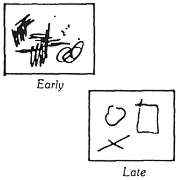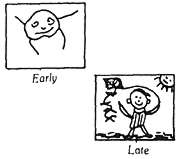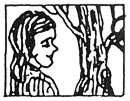The purpose of this article is to review briefly the developmental stages of children's art from ages two to fourteen and to offer a few suggestions for activities and materials relative to those stages, as an aid to providing confident and creative child care in art therapy and related areas. In her book, The Artist In Each of Us, Florence Cane states that ... what we need to be taught is not art, but to believe in ourselves, our imagination, our senses, and our hands, to free our bodies and our spirits that we may work and live according to our visions ... From failures and victories come skill, and skill itself is technique.
The goal in providing art activities for children is not to train artists but to offer opportunities for self discovery and self discipline so children may relate to their environment as healthy and integrated individuals.
Developmental stages
Essential to sensitive guidance in planning and executing the programme
is knowledge of what to expect and what not to expect of children. By
understanding normal development in child art, a basis of comparison is
provided by which we are able to evaluate deviations in children who are
experientially deprived, emotionally disturbed, mentally retarded, deaf,
or blind.
Extensive, documented studies of child art in previous and present cultures indicate that children (and adults with delayed experiences) grow through a series of predictable developmental stages in their drawings and paintings; recent studies involving play with clay also suggest similar patterns exist therein.
The three major stages have been descriptively named
These stages reflect the overall growth and development of the child between about two and fourteen or more years. Child art is acknowledged to be uniquely different from adult art. A child begins to draw as a normal part of his effort to explore, to manipulate, to seek order, and to control himself in his environment. Children who are appropriately encouraged along developmental patterns tend to achieve a higher level of skill. The majority of adults today have not attained a level of competence beyond the schematic stage due largely to lack of sympathetic stimuli. The adult who has not achieved the skill to draw representational realistic forms often feels he can't draw a straight line.
Scribbler stage
The Scribbler (from about age two through five) initially sees no
connection between the crayon in the hand and the mark on the paper as
he embarks on his initial uncontrolled manipulation; drawing is a motor
activity – an extension of bodily movement which can become expressive
of feelings and later, of ideas. Rhoda Kellogg has identified twenty
basic scribbles children use most often, made of lines that are
vertical, horizontal, diagonal, circular, curving, and waving, as well
as dots; these scribbles are applied in primarily seventeen major
patterns.

After considerable practice, rudimentary linear forms are attained which may be called pre-schematic: circles, ovals, triangles, rectangles, squares, crosses, and X's. Varied cornbina tions of these forms result in the child's discovering universal designs which have been used in every primitive culture “the sun, mandala, and radial. During early scribbling (and sometimes into the schematic state), colour is used emotionally, i.e., the child uses whatever he likes best or what is in closest proximity to him; there is not relationship to colour in real life. Numerous colours are enjoyed; most often four or more are used in one drawing. Normally red, yellow, blue and green are favourites. Children begin to name drawings as they complete them. A show and tell time offers insight into what the child is feeling and thinking at the moment. “Tell me about your picture" is a better approach than “What is that?" be cause the latter could be interpreted as a failure to draw well enough to communicate the intended feeling or idea. “I" and “my" are prominent in vocabulary. Drawings show little individuality until the child moves into the Schematic stage.
Schematic stage
We know the child is in the Schematic state (about five through nine)
when his linear drawings can be identified as definite shapes of
specific, recognisable forms, e.g. a man or a house. His primary
interest is in people; his human schema will be drawn uniquely and
personally; his schema can be recognised from that of other children;
the details within it reflect his own self-awareness. (Use of colouring
books tends to destroy a child's confidence in his own schemata.) His
desire for adult and self approval become more acute as this stage
develops. Front face views precede profiles.
Size is related to importance, so what is most interesting to him may be largest.

Favourite subjects are humans, houses, and plants; others are animals, trains, cars, airplanes, recreation, games, and amusements. Early schemata (linear forms) are drawn as if floating all over the page in odd positions – a table may be drawn round as if seen from above; people seated at the table may be extended out in all directions around it.
Later schemata are related to a baseline at the bottom of the picture or to multiple baselines covering the page from top to bottom. The baseline is highly significant in indicating readiness for co-operative play and thinking, such as planning and executing group murals and puppet shows.
Using a line across the top and a baseline at the bottom, with air in between, is a further evolution. Houses and people are often transparent.
Colours are used to fill in and enrich the linear schema and begin to be related to real life, that is, the grass and trees are green, the sky is blue, the apple is red. Red and blue are favourite colours. Drawings are based on memory of things rather than actual appearance, and may incorporate sensory impressions about smelling, tasting, hearing and feeling.
Realistic stage

As the child perceives more of reality and becomes more skilful in expressing what he sees, knows, and feels, he normally proceeds into the True-to-Appearance stage (about nine through fourteen years or older). Realism generally begins along with early adolescence, and the child who indicates less co-operation with adults may be guided into cooperative thinking by using themes of people helping one another. Peer planning and group executing of activities is now enjoyed more. More details are perceived and drawn; drawings show girls in skirts and boys in long pants. New spatial concepts include overlapping and receding planes and, later, the use of linear perspective. Subtle shading of form replaces simple, flat areas of colour; tints and shades of colour are more preferred.
Around fourteen years and over, monochromatic colour is frequently used; colour is used to express moods and feelings and to portray actual true-to-appearance colour.
Favourite subjects are houses, ships, plants, and people; other subjects may include animals, insects, fish, vehicles, weapons, and landscapes. Interest in drawing the human head supersedes drawing the drawing entire figures when the skills of eye-hand coordination do not keep up with the child's ability to see realistically.
(An aware teacher can stimulate lively sessions in which children pose for one another as an aid to overcoming this problem.)
As the realistic stage progresses, the adolescent tends to draw in one of two ways:
he perceives and executes work with an emphasis on the visual, exteriorview of things; or
he expresses himself on a feeling or subjective level dealing with muscular sensations and touch impressions so that the forms he draws may seem distorted in appearance.
Special children
The preceding review of the stages of development in the art of normal
children provides a basis for understanding what to expect of special
children. The evaluation of children from a few isolated drawings is not
recommended for inexperienced persons. A valid evaluation can be made by
collecting daily spontaneous pictures in a personalised folder. Date
each work; record significant verbalisations the child makes about the
work. (These can be noted on back of the picture.) These become a part
of a permanent record of growth and change. By using such a portfolio,
and by observing spontaneous art sessions where free choice of materials
and subjects are offered, a child care worker can learn to determine the
developmental level of each child.
It is useful to know that a child may draw better with crayon than with chalk because he has used it more often; even adults must go through an exploratory, manipulative period when they first try a new medium before using it with the skill of their normal level of competency.
An emotionally disturbed child who has been deprived of normal creative expression due to temporary organic dysfunction, parental neglect, or emotional inhibition may progress expediently toward the developmental level of his normal chronological age if provided with materials and sympathetic motivation, in an atmosphere conducive to free, personal growth. A disturbed child who is withdrawn, frightened, or angry may be encouraged toward acceptance of self and the surrounding environment through appealing, feely fun, touch experiences in simple art activities, handling and manipulating materials like clay, finger paint, or collage.
Mentally retarded children develop more slowly than normal ones. For them, art stages occur later and require more extended time to develop. The content of their work may reflect the interests of their chronological age. The adolescent slow learner with an I. Q. of at least 70, no matter what his grade level, tends to use some of the subject matter found in the art work of the normal adolescent. An adolescent in this category is interested in social events at which both sexes are present. Boys like to portray sports, daring deeds and mechanical objects. In general, the retarded child cannot cope with complex tasks but can happily work at projects similar to those of his peers “tasks which can be geared to meet the mental age of younger children. Their pictures may lack movement or rich detail, and tend to be more stereotyped with more misconceptions in proportions of forms.
Their compositions often lack unity, a centre of interest, or texture. Their use of line and colour is successful, though colour is pure and seldom mixed. Art provides the retarded child with an opportunity for successful achievement on his own level, and he will often sustain interest in an art activity after normal children have expended their interests elsewhere.
Studies show that pictures by deaf children are especially rich in details, due to acute visual memory, but contain fewer people or animals and social interactions. They often depict cruelty and violence; thus, art may be exceptionally important as a mode for them to express anxiety, fear and frustration resulting from their condition of isolation.
When blind children have been taught to draw successfully with a Braille technique, the forms they produced lack detail and resemble those of much younger children. In general their expressions are based on feelings, in that they project entirely an inner world of tactile and bodily sensations. Clay has been used frequently by the blind of all ages; schema are arrived at by feeling and touching selves and objects. Work is made by combining many bits of clay in an additive construction. Tactile activities of carving, modelling, tooling foil and leather, collage and mosaics, painting and finger painting appeal to blind children. Since these children develop a keen sense of hearing, music and other sounds can enrich their art experiences greatly. Rhythm, movement and line may be perceived through sounds and translated into visual expressions.
Conclusion
In summary, children's art follows a sequential pattern of growth and
development. The art of each child reflects his level of self awareness
and the degree to which he is integrated with his environment.
Children may be encouraged to be perceptive, imaginative, and creative when they are guided by knowledgeable, sympathetic persons who allow them freedom to express ideas, feelings, and fantasies in a mode appropriate to their developmental level and ability. This sort of freedom is nurtured in an atmosphere of acceptance where children are provided with a time, a place, suitable materials, and an idea motivated from the child's own world or experience and feelings. The attitude of the adult or teacher ... must be one of willingness to submerge his own conscious, rational mind and hold it in check while the student's perceptive, imaginative, and emotional self is given free reign. Creative expression requires a kind of moral courage “a spirit of adventure, a play instinct, an ability to take a change. One must not only be fearless of his environment, but the environment itself must also be warm, encouraging – and inviting.
Child Care Work in Focus, copyright the Academy of Child and Youth Care Practice